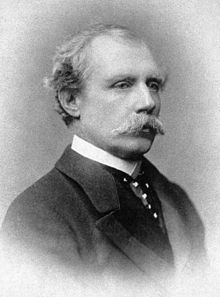Charles Brooke, Rajah of Sarawak
| Charles Brooke | |||||
|---|---|---|---|---|---|
 | |||||
| Rajah of Sarawak | |||||
| Reign | 3 August 1868 – 17 May 1917 | ||||
| Predecessor | James Brooke | ||||
| Successor | Charles Vyner Brooke | ||||
| Born | Charles Anthoni Johnson 3 June 1829 Berrow Vicarage, Burnham-on-Sea, Somerset, England | ||||
| Died | 17 May 1917 (aged 87) Cirencester, Gloucestershire, England[1] | ||||
| Burial | |||||
| Spouses |
| ||||
| Issue | with Dayang Mastiah:
| ||||
| |||||
| Dynasty | Brooke | ||||
| Father | Francis Johnson | ||||
| Mother | Emma Johnson | ||||
| Military service | |||||
| Allegiance | |||||
| Branch/service | Royal Navy | ||||
| Years of service | 1842–1856 | ||||
| Rank | Lieutenant | ||||

Sir Charles Brooke, Rajah of Sarawak GCMG (Charles Anthoni Johnson Brooke; 3 June 1829 – 17 May 1917), born Charles Anthoni Johnson, ruled as the head of state of Raj of Sarawak from 3 August 1868 until his death. He succeeded his uncle, James Brooke, as the second White Rajah.
Biography
[edit]Charles Anthoni Johnson was born in Berrow Vicarage, Burnham, Somerset, in England, to the Reverend Francis Charles and Emma Frances Johnson, née Brooke. Emma was the younger sister of James Brooke, the first Rajah of Sarawak. In addition to Charles, Francis and Emma had other children: Captain John Brooke Johnson (1823–1868) (later Brooke), Mary Anna Johnson (b. 1824), Harriet Helena Johnson (b. 1826), Charlotte Frances Johnson (b. 1828), Captain (William) Frederic Johnson (b. 1830), Emma Lucy Johnson (b. 1832), Margaret Henrietta Johnson (1834–1845), Georgianna Brooke Johnson (1836–1854), James Stuart Johnson (1839–1840), and Henry Stuart Johnson (b. 1841).
Brooke was educated at Crewkerne Grammar School and entered the Royal Navy. He entered the service of his uncle James, the first Rajah of Sarawak, in 1852, took his name, and began as Resident at the Lundu station in the Raj of Sarawak. In the 1857 rebellion against the White Rajah, Charles Brooke helped his uncle put down the rebellion led by Liu Shan Bang with his force composed of Ibans and local Bidayuh tribes. It is noted that Brooke's Iban forces pursued the remaining rebels to Bau, where they killed the 3,000 villagers including women, children and the elderly in a massacre. In 1865, James named Charles as his successor.
Brooke married Margaret Alice Lili de Windt at Highworth, Wiltshire, on 28 October 1869; she was raised to the title of Ranee of Sarawak with the style of Her Highness on the same day. They had six children, three of whom survived infancy:
- Dayang Ghita Brooke (1870–1873)
- James Harry Brooke (1872–1873)
- Charles Clayton Brooke (1872–1873)
- Charles Vyner Brooke, Rajah of Sarawak (1874–1963)
- Bertram Willes Dayrell Brooke, Tuan Muda (1876–1965)
- Henry Keppel Brooke, Tuan Bongsu (1878–1927)
Brooke’s son Charles Vyner Brooke succeeded him as the third and last White Rajah. He had another son, Esca Brooke (1868–1951) from a previous marriage with a Malay woman known as Dayang Mastiah. Esca was sent to England at the age of six, cared for and later adopted by the Reverend William Daykin. Eventually, they moved to Canada. Esca married and had three children.[2] Brooke lost an eye at some point in a riding accident, and allegedly replaced it with a false eye intended for a stuffed albatross.[3]
Brooke resigned his commission in the Royal Navy in 1861[1] and continued the work his uncle had started, suppressing piracy, slavery, and head-hunting,[1] while encouraging trade and development and expanding the borders of his domain as the opportunities arose. In 1891 he established the Sarawak Museum, the first museum in Borneo. Brooke founded a boys' school in 1903, called the 'Government Lay School', where Malays could be taught in the Malay language. This was the forerunner of SMK Green Road.[4] By the time of his death, Britain had established a protectorate over Sarawak, it had a parliamentary government, a railway, and oil had been discovered.
All three White Rajahs are buried in St Leonard's Church in the village of Sheepstor on Dartmoor, Devon.
Honours
[edit]British Honours
At least two Bornean species were named in Brooke's honour:
- Brooke's Squirrel (Sundasciurus brookei), named by Oldfield Thomas
- Cervus brookei, a deer named [6] by Charles Hose in 1893
See also
[edit]- Fort Margherita
- Genealogy Johnson/Brooke
References
[edit]- ^ a b c "Obituaries -- Sir Charles Brooke". The Sun. New York, NY. 18 May 1917. Retrieved 13 June 2015.
- ^ 'The White Rajahs of Sarawak - Dynastic Intrigue and the Forgotten Canadian Heir' by historian Cassandra Pybus, 1996, Douglas & McIntyre, Vancouver/Toronto, ISBN 1-55054-603-1
- ^ Beolens, Bo; Watkins, Michael; Grayson, Michael (2009). The Eponym Dictionary of Mammals. Baltimore: The Johns Hopkins University Press. ISBN 978-0-8018-9304-9.
- ^ Gin, Ooi Keat (1997). "The Attitudes of the Brookes Towards Education in Sarawak 1841-1941". Journal of the Malaysian Branch of the Royal Asiatic Society. 70 (2): 53–67. JSTOR 41493337.
- ^ "The London Gazette". No. 25825. 8 June 1888. p. 3185. Retrieved 22 April 2022.
- ^ "Description of a new deer from Mount Dulit, Eastern Sarawak". Annals and Magazine of Natural History.
Further reading
[edit]- Pybus, Cassandra (1996). The White Rajahs of Sarawak: Dynastic Intrigue and the Forgotten Canadian Heir. Vancouver: Douglas & McIntyre Ltd. ISBN 1-55054-603-1.
- Ranee Margaret of Sarawak (2001). My Life in Sarawak. Oxford: Oxford University Press. ISBN 0-19-582663-9.
- R.H.W. Reece (1982). The Name of Brooke, the End of White Rajah Rule in Sarawak. Kuala Lumpur: Oxford University Press. ISBN 978-0-19-580474-4.
- Dictionary of National Biography entry
